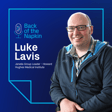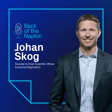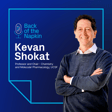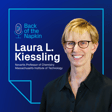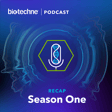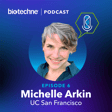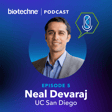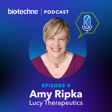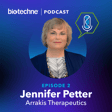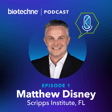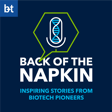Become a Creator today!Start creating today - Share your story with the world!
Start for free
00:00:00
00:00:01

Alessio Ciulli: At the Forefront of Targeted Protein Degradation
Alessio Ciulli is a Professor and Chair of Chemical Structural Biology at the University of Dundee, where he is also the founder and director of the Centre for Targeted Protein Degradation (CeTPD). He is also the scientific founder of Amphista Therapeutics. This conversation covers the significant moments in Alessio’s career where he began to shape an exciting new approach in drug discovery: targeted protein degradation.
CeTPD page: https://www.dundee.ac.uk/cetpd
Alessio’s group page: https://www.dundee.ac.uk/people/alessio-ciulli
Alessio’s Twitter: https://twitter.com/alessiociulli
Transcript
Accidental Discoveries & Scientific Pioneers
00:00:03
Speaker
A discovery is said to be an accident meeting a prepared mind, but every story behind a discovery is different.
00:00:11
Speaker
Perhaps the idea is conceived in a light bulb moment or a brainstorming session or captured in scribblings on the back of a napkin. Here, we introduce you to scientific pioneers, taking you beyond their publication and into innovation corner to hear the untold stories behind their discoveries.
Introduction to Hosts & Sponsorship
00:00:30
Speaker
This podcast is brought to you by Biotechnic and I'm your host, Alex Maloney.
Professor Alessio Chulli's New Facility
00:00:37
Speaker
Our guest today is Professor Alessio Chulli from the University of Dundee and we actually recorded this episode from a brand new facility Alessio has founded called the Center for Targeted Protein Degradation. And in case you're not familiar with this, don't worry as Alessio does a fantastic job of explaining this modality early on in the episode.
00:00:57
Speaker
I feel incredibly lucky to be here as this facility is something that has been built around Alessio's passion and enthusiasm for what he does with like-minded people that are focused on a goal of expediting discovery and development and translation of these protein degraders or protex as you'll hear them called into the clinic.
00:01:16
Speaker
Now there's already around 15 of these protacts in the clinic, which is remarkable considering the idea. Only really began to gain traction around a decade ago.
Collaboration with Craig Cruz & Protac Development
00:01:27
Speaker
And it's a moment that Alessio was instrumental in as he teamed up with Professor Craig Cruz from Yale University to make the first small molecule protacts that recruited an E3 ligase called VHL. And we discussed this moment in the episode.
00:01:44
Speaker
Alessio's passion and enthusiasm and talent for what he does is incredibly stimulating and speaks to his enormous success and I could see that he really takes great pleasure in sharing his success with those around him and really aims to inspire innovation and motivate scientists to go on and do great things and I think that's why you're going to see some fantastic work coming from this facility.
00:02:11
Speaker
I noticed while in Alessio's office that he had a sign on his desk that his team had given to him and it said, the man, the myth, the protein degrader. I think that's a fantastic way to start this episode off. So welcome to back of the napkin.
Alessio's Journey into Science
00:02:31
Speaker
Alessio, Julie, welcome to Back of the Napkin podcast. It's great to have you here and on the show. Thank you for having me here. It's a pleasure to have the opportunity. I've got three thank yous to say before we start. The first one is thank you for agreeing to be on the podcast. The second one is thank you for having me here at the new Centre for Targeted Protein Degradation in Dundee.
00:02:58
Speaker
And the third is for having me to come up with the name for this podcast. So back of the napkin, as it kind of suggests, is about the moments where people come up with great ideas and sometimes they want to capture these. And often the closest thing is a napkin. And I heard some great stories about you being out for dinner and writing down your ideas on napkins. So that was very much why I decided to go with the name.
00:03:26
Speaker
Back of the napkin, so. I like that. Yeah, good, good. Okay, so let's lay some foundations then for your career in science. And let's go back to the beginning. And so, how did you get into science? Oh gosh, you know, I get asked that question more and more. And I think my love for science has always been, you know, the curiosity of learning how things work, understanding.
00:03:55
Speaker
how things work, what's behind, what we see, what we touch, the matter that surrounds us, us as human beings.
Academic Pursuits and Influences
00:04:05
Speaker
And that was one of the motivations for me to study chemistry, because I always felt that with chemistry, I could always go deep into that fundamental understanding of structure, how things look like, how things work.
00:04:23
Speaker
And I actually don't think as a kid I wanted to be a scientist. When I was asked that question, I remember I used to tell, I used to answer that I wanted to be a journalist. And I suppose it's because my dad used to work in a newspaper and so I had that
00:04:44
Speaker
close to home. But I guess it traces back to when I got excited with chemistry and my parents bought me a piccolo chemical, the little chemist. So this big box with lots of different salts and lots of different things that you could do and mix. Did you have the lab coat?
00:05:13
Speaker
I think I might not remember that. I don't think so. But it was all done by health and safety standards while at home. So that's what got me excited about seeing something new, seeing transformations and trying to understand how things work.
00:05:36
Speaker
And then when you were at school, was chemistry like this subject that you just kind of had a connection with? Was this your favorite subject at school? Yeah, interesting. Again, the answer is no. My favorite subject was maths. It always was maths and it continued to be.
00:05:57
Speaker
And we'd only study chemistry later on in the high school.
PhD and Fragment-Based Drug Design
00:06:02
Speaker
Of course, we studied it as well in the middle school, but at the level that I got excited was mainly, namely in high school, and I'd already sort of studied on my own. Yeah. Okay, so you did some secret classes. Yeah, I was just, you know, I was reading it all about by myself, but no, it wasn't, it was maths.
00:06:24
Speaker
Yeah. So when did the decision come to move into chemistry? Did you study chemistry at university? At university, yeah. So my mom still sort of kind of blames me for that, or at least regrets, not regrets that decision, but at least reminds me of how peculiarly I chose that because she wanted me to do engineering. Okay.
00:06:52
Speaker
Because in her mind, that's where there were more job opportunities. And of course, my love for maths and for creating things that way seemed a natural choice to do engineering. And in a way, I suppose in my scientific career, I've always liked to create and engineer things by doing it using chemistry. But then in the end, I decided to do chemistry.
00:07:16
Speaker
Yeah, okay, so you're at the University of Florence. Yes, of Florence, yeah, correct. And you must have liked then deciding to go on and do a PhD. Yes, yes, I mean, absolutely. In Florence, you had to choose already the subject and then in the first few years, you were still doing maths, you were still doing physics, you were still doing computing, you weren't just doing chemistry.
00:07:43
Speaker
And so there was that element of breadth that I still liked to keep. Nonetheless, yes, the different aspects and facets of chemistry kept inspiring me and motivating me to learn more. And I think it was also a very inspiring teacher. So my first teacher at university on general in organic chemistry, Professor Ivano Bertini,
00:08:10
Speaker
a great scientist and the late Ivano Bertina. And then that motivated me to join his group to do my thesis. So I think ultimately we underestimate the value of our teachers and the people that teach us. And they're very influential I think to our career path. And that very much shaped ultimately the kind of science that I ended up getting excited about.
00:08:37
Speaker
And what was this science? What were you working on, Ivana, with? Yeah, so when I joined his group, so he at the time was the director of what is already there, a Center for Magnetic Resonance in Florence, a very big institute. It's always had some of the largest and most advanced cinema spectrometers in the world.
00:09:01
Speaker
And, um, and so I still remember Ivano was telling me how he was excited and interested to get into ligand screening into proteins, which, uh, you know, was a future for NMR at the time was the late 1990s, early 2000s. And, uh, how he wanted me to do it with the calculator, uh, and then validated experimentally. So that inspired me and got me into.
00:09:27
Speaker
into the field, which then hooked me in to study fragment-based drug design and then go to Cambridge and do my PhD there. Yeah. There was a pretty landmark publication that came out around this time. There's a Steven Fezzik, Saar by NMR. Correct. Was this something that you had seen and inspired you? Yes, absolutely. So those papers were very much like the Bible for me. It was amazing work.
00:09:56
Speaker
and I read every bit of it and it inspired me to learn more about the field and to understand how to do those kind of experiments and to think about how small molecules bind to proteins. Absolutely. There was a landmark paper in Science published in 1996, but actually perhaps the two most influential papers for me at the time were
00:10:20
Speaker
Two back-to-back papers in JAX. I think from shortly after, I don't remember the year now, maybe 99, where Steve and his team at the time at Abbott were targeting a protein called stromalizing, also MMP-free. And my thesis with Ivano was to look at matrix metalloproteinase as MMPs, so it was spot-on relevant.
00:10:46
Speaker
Okay, right. So talk me through the next chapter then, which I believe is you moving over to the UK to Cambridge to do your PhD. So how did this happen?
00:10:57
Speaker
Yeah, so I had already spent a year in Cambridge as an Erasmus student. I was very fortunate that the University of Florence had a program, an Erasmus program agreement with the University of Cambridge. And I was very lucky that myself and two friends of mine got into this program. And so we spent a year during our fourth year, there was 99, 2000, studying in Cambridge.
00:11:27
Speaker
So I loved every bit of it. I loved the environment. I loved being in a college. I loved the way chemistry was taught and I loved the experience. And so I always dreamt of the opportunity to maybe one day come back and do a PhD. Who knows?
00:11:45
Speaker
And I was fortunate to get the studentship to do that with the Gates Cambridge scholarship. And so then I didn't think twice. And then at that point, yeah, my mom was really upset because she thought I would never come back. I told her, it's only three years, but I think they sensed that I would not come back. Yeah, yeah. Still here in the UK. Yes. So what was your PhD looking at?
00:12:14
Speaker
Yes, so my PhD was about novel approaches to study protein ligand interactions, novel fragment-based approaches. And so I
Targeted Protein Degradation
00:12:29
Speaker
did my PhD with Professor Chris Abel, one of the co-founder of Astix at the Time Technology. And so really, the aim of the project was to explore a variety of biophysical techniques
00:12:44
Speaker
to study how fragments as more molecules in general bind to protein, and particularly to study weak interactions. So at the time, in the field of fragment-based screening, there were typically two main areas. It was x-ray crystallography and Aztecs was a pioneering company for that. The idea being to soak
00:13:05
Speaker
a cocktail of small molecule called fragments, meaning very small, to see what they would bind to protein and then use that information to build higher affinity inhibitors or ligands. Another approach was the NMR approach pioneered by Steve Fezik.
00:13:22
Speaker
So the idea of my project was to explore alternative technologies, alternative methods, to look at the protein, ligand binding, equilibria. So including isothermal, titration, calorimetry, surface plasma resonance, mass spectrometry. So you learned a lot of techniques. I learned a lot of techniques, and I learned a lot of actually the process of
00:13:48
Speaker
How do you actually think about identifying novel chemical matter and how do you think about it in the context of what the pharmaceutical industry would ultimately require for developing new drugs and how that early process
00:14:08
Speaker
is so important to sort of catalyze them the rest of the drug discovery process. And so, yeah, it was an exciting time for the field. Yeah, good PhD. So Chris Abel's involvement then in starting Aztecs, was this something that appealed to you, kind of this entrepreneurial side? Yes. Was that something that kind of excited you?
00:14:33
Speaker
Yes, absolutely. Having the opportunity to do a PhD in collaboration with, at the time, a biotech company, considered a biotech company, which had clearly the potential to grow into a larger drug discovery company.
00:14:53
Speaker
was really appealing to me. And in fact, it's something that has been a continuum for me in my career already. Back in Florence, during my internship with CHERM, Ivano Bertini was keen to do a startup. And in fact, he created a startup called Jotto Biotech.
00:15:16
Speaker
And I remember that he was keen for me to be involved. And I said, well, I'm just a student. I want to learn. I want to continue to do research. But that process of university academic research potentially catalyzing the starting up of a new venture captivating my imagination. And then when I had the opportunity to do the PhD with Aztecs and actually try it for real,
00:15:45
Speaker
in real life and how my PhD sort of aligned or overlapped to what the company was doing was definitely very inspiring. And again, it's another example of how your experiences as a student with your mentors and with your supervisors can have a tremendous impact on how you think and how you potentially develop your own career. And you might not imagine or
00:16:15
Speaker
or realize that, but they're definitely there. And that's certainly been the case for me as I then later on got involved in more and more of company formations and ultimately culminating in me spinning out and fisting. Yeah. Okay. Well, let's get to that in a second. So let's start and buy kind of your transition into the field of targeted protein degradation.
00:16:39
Speaker
There'll be a lot of listeners who are very familiar with TPD on this podcast and some people who will know what a protack is, but maybe you could give just a quick introduction to targeted protein degradation and what a protack is. Sure. So this is a really exciting new approach to develop drugs.
00:16:58
Speaker
And so unlike conventional drugs that typically block a target, for example, an enzyme, they bind to the active site and they inhibit the activity of that protein or they block a specific interaction of that protein. We often call them inhibitors or antagonists or blockers.
00:17:21
Speaker
We targeted protein degradation, we do something very different. And so with our molecules, we combined anywhere on the target protein. It doesn't have to be the active site.
00:17:33
Speaker
And then what that molecule then does is it hooks up to a different protein that is part of the native, sort of natural mechanism that nature has evolved to degrade protein. It's called the most widely used, is it?
00:17:52
Speaker
It's called the ubiquitin proteasome system. And now we bring together our target to that key protein on the ubiquitin proteasome system, typically in so-called E3 ligase. And so we now recruit them into proximity. We actually
00:18:10
Speaker
from what we call a ternary complex. We bring these two together and now that protein is destined for destruction because the enzyme now transfer a tag to it, it's called ubiquitin, and that tag marks the protein for degradation and for destruction. So it's completely different. We don't block the target, we actually very rapidly degrade it inside the cell.
00:18:36
Speaker
And a question I have to ask if I should is, do you call it a biquitination or a biquitillation? Oh, I'm agnostic. Both words are totally correct. But yes, if you ask me, I normally say ubiquitination. Ubiquitination, yeah. I've seen debates on Twitter about... But both are correct. Both are correct, yes.
00:18:59
Speaker
So what's catalyzed your entry into this? Was there a specific moment during your time in Cambridge where you heard about this? Yes. So training in fragment-based drug design, obviously I had a deep interest in developing molecules that bound to proteins. And so I had been exposed to the concept of fragment linking, where you have two ligands that bind on the target protein and you connect them together.
00:19:29
Speaker
to improve the affinity. But we were always thinking about one molecule that bound to one target, and the molecules that we were developing had to target a functional site to be biologically active, so-called inhibitors.
00:19:48
Speaker
And so as I was scouting for new ideas and always in the hunt to think about how this approach could be applied to something different, then one day I met Craig Cruz at a conference. We were both speaking at this meeting.
00:20:03
Speaker
And so you know it was what i guess one of those it wasn't quite a back of a back of a napkin conversation i don't think i don't recall is either of us using that but we certainly had a very exciting conversations at dinner.
00:20:22
Speaker
and we both enjoyed our respective lectures. I learned from his talk about this idea of protacts that I had not heard about before. He heard about my work from fragment-based drug discovery, and we decided to team up. I decided to visit his lab, which was actually something I always wanted to go to the US and spend some time there to learn about.
00:20:51
Speaker
firsthand how it is to do science in the U.S. And that spared the start of a collaboration that the rest is history led to the development using fragment-based drug design of the VHL ligand, which have been very important contribution to the field of protex.
00:21:10
Speaker
Yeah, so there's some papers then that were kind of around that time, I presume, around 2012 that you publish on these small molecule ligands that bind to VHL. And the thought was, okay, we're going to make these small molecules and we're going to have to functionalize them, we're going to be able to degrade proteins with VHL.
00:21:38
Speaker
So what was the kind of order that things happened? When did you finally kind of get a protact that you could use your new ligands for for VHL and successfully degrade a protein?
00:21:48
Speaker
Yes, so this is where Craig and I encountered quite a lot of resistance in the field. A lot of people thought this is not going to work. We always believed that if we could get good quality molecules, we would get there. Because until then, the field had used peptides, and it was clear we needed to move away from it.
00:22:16
Speaker
There was always the key question, will this ever work? What affinity do you need? What kind of chemical structure do you need? So we didn't know the answer to this. I guess we just got excited about the opportunity to build good quality molecules and still remember the day when
00:22:38
Speaker
postdoc in my lab in Gewam all this all the first ever structure with the ligand bound where we could see the electron density feeling exactly where we are expected it to be and that was kind of really Eureka moment it really motivated us and got us thinking hey you know with now we're in the right track and so I think I think it's
00:23:01
Speaker
When you reflect back on these and many other examples of success scientific stories that come from my group and breakthrough discoveries, I suppose it's always hard to absolutely exactly imagine
00:23:20
Speaker
where you might be and you have to sort of believe that you can get there and then you just take one step at a time. Because if you think too hard about what things might be, you might not actually ever get there and you might prevent yourself from making the key discovery. Sometimes it's just about asking the next question and say, okay, where can we go next?
00:23:45
Speaker
And so in that particular case, we knew that hydroxyproline was a key starting point because that's what nature had evolved. And so we actually really struggled to detect the binding, but we had the confidence that if we could grow enough around it, it would bind.
00:24:07
Speaker
And so when we demonstrated that, then the next question was, at what point could we actually believe that these compounds have legs and could be used for the protack? And one of the things that was good to have was this was a known ligase with a known substrate, so we could test whether the compound could be active inside the cell.
00:24:30
Speaker
And it was only until we developed compounds that could break the barrier of nanomolar binding affinity that we really started to convince ourselves that we could really have molecules that could be useful for protect design.
00:24:52
Speaker
And then we started making protacks. And in my lab, that was a Eureka moment where we made the compound MZ1. A simple peg-free linker that linked out now optimized DHL ligand, which we had just showed that we could detect in his own right activity inside the cell.
00:25:13
Speaker
linked to another ligand that we were working in the lab for a different target. So you always start where you're at and you look at what you can do to move things step by step. I think it's the lessons I've learned.
00:25:30
Speaker
Yeah, the incremental one step at a time. Exactly. And I think we fool ourselves that science is a big leap. And we wake up one morning and you discover this huge big leap that now takes you to Mars. Unfortunately, it doesn't work like that. And if you expect or try to do that, you won't get to Mars and you'll get disappointed. And so I think one step at a time is a good advice I've learned.
00:26:00
Speaker
Okay, so your MZ1 is one of the most widely cited protacs, if not the most.
00:26:10
Speaker
So was this why you're still at Cambridge or do you know you'd move now? Yes,
Move to Dundee & Research Environment
00:26:15
Speaker
exactly. I had moved already by well over a year in Dundee. And so actually this in a few days time, it will be exactly 10 years. Ten year anniversary. Congratulations. Thank you. Yes, I moved my lab from Cambridge beginning of April 2013.
00:26:35
Speaker
Yeah. Yeah. Okay. And why Dundee then? So Dundee, I mean, now very different since, you know, it's on the biotech map, but why Dundee at the time? What made you move? Yes. Again, it was that intuition and that projection that our science could go much deeper and could go in a new brand new direction.
00:27:01
Speaker
And it was a combination of being a fantastic place for science, a very strong institute where there were lots and lots of like-minded colleagues who I could talk to and who were interested about what we were doing and that I could see where we could work together and collaborate, a very collegiate environment.
00:27:29
Speaker
a very supportive environment, but also an environment with very high-end facilities and very well resources so that we could really take our science now to the next level.
00:27:47
Speaker
Also, it plays very strong in biology and so being a chemist and so having been for many years in a traditional chemistry department, I always felt that perhaps there was a kind of glass ceiling and we couldn't really go into biology ourselves and I thought coming to Dundee we would have that opportunity and it turned out to be the case.
00:28:11
Speaker
But also it's an amazing place to live. It's an amazing, it's a beautiful, beautiful city and a beautiful part of Scotland and of the UK. And I just fell in love when I visited and I've never looked back.
00:28:26
Speaker
Yeah, agreed and I'll say again, it's great to be here. I love coming up to Scotland and Dundee is gorgeous. Very jealous you get to live up here. You're always welcome, any time. Thanks, Alessia. Okay, so you're here now then in Dundee, you've got your own group. So, what I'd like to try and understand in
00:28:47
Speaker
And of course this podcast is called back of the napkin is how you come up and how you innovate and furthermore, how you inspire your group to think and innovate as well. So yeah, what can you say to that?
00:29:03
Speaker
Oh, boy, that's a million dollar question. I think there isn't a fixed recipe. There isn't a protocol to follow. And there's no question that different individual would give different answers, different people innovate in different ways.
00:29:30
Speaker
But I certainly have learned that the best way to innovate is keep an open mind, keep thinking about what you do.
00:29:42
Speaker
And always have an open mind for maybe when you see unexpected results. So our best projects and our best innovations have come most of the time from unexpected surprising results.
00:30:03
Speaker
We just published a story which has come completely from an unexpected, surprising result where we had the protack supposed to work for a particular ligase where we tested it on the knockout cell line that didn't have a ligase. It was still working. That spurred a completely new project. So I think that's the best way to innovate and to pursue and formulate new ideas.
00:30:34
Speaker
But of course, at the end, you always have to have a good vision of where you're trying to go and what you're trying to do and try to stay on track.
00:30:46
Speaker
So that perhaps these are surprising unexpected results still take you in a slightly off path, but it's still part of what you're doing. Because otherwise this could just be distractions, if that makes sense. Yeah. So you've got a better chance of finding something if you're in a kind of defined space looking for it.
00:31:06
Speaker
Correct. We often hear that luck meets the prepared mind. I think that's very true. You search your luck. Activity is really important. You can think deeply about how to do experiments or what to do and try to be perfect. Sometimes you just have to get on them.
00:31:31
Speaker
Obviously carefully designed experiments are very important with the right controls and by no means that's really important in science. But sometimes don't overthink too much and just get on and do what you can with what you've got. I think it's really important. With a long vision, with a long view of where you might go with your research program,
00:31:57
Speaker
in a way that is exciting and it's not sort of boring.
Founding of Amphista Therapeutics
00:32:03
Speaker
And that excitement comes from doing things differently or trying things that are maybe hard, that are challenging. Try to tackle some challenges. But still be very practical in what you can actually achieve with your science. Yeah, I think that's great advice. So let's come on then to Amfister, therapeutic.
00:32:28
Speaker
Talk me through what happened here. What was the moment where you decided, okay, we need to start a company. We've got something that, yeah, we need to turn into a company. How did this happen? Yes. So maybe let me backtrack a little bit back to MZ1 because I think that's important. When we discovered MZ1 in the field, we had never seen a degrader that worked like that.
00:32:52
Speaker
And so that was really Eureka moment. Until then, we didn't know if we could degrade really a protein. We didn't know if we could degrade it that fast at such low concentration, meaning that portantly, that efficiently.
00:33:10
Speaker
And particularly, as I was interested in studying the proteins degraded by MZ1 and engineering selectivity on that protein, now with MZ1, we observed that it degraded preferentially one of those proteins. And that was really exciting to us because it suggested, oh, we don't need to engineer that in. We can actually achieve it on the endogenous protein.
00:33:33
Speaker
with a small molecule. And the warhead ligand wasn't selective? Wasn't selective, exactly. Absolutely, you got it. Yeah, so the warhead ligand was not a selective inhibitor. It would block all those protein equally. And now suddenly, when turned into a protack, into a degrader, and recruiting these additional ligase, it now proved to be more selective and degrade one of those protein preferentially.
00:33:58
Speaker
And that was where the curiosity came, right? The unexpected result, because you'd imagine it binds all the same, so you'll degrade all the same. Instead, it wasn't. And that's unexpected result, motivated, then a lot of work to try and figure out why that was. What made the compound so exquisitely specific?
00:34:16
Speaker
And that motivated then our work to solve the structure of that ternary complex, which we published two years later. So the first time in the field that we saw a protack bound with both the ligase and the target protein simultaneously engaged. And that, for the first time, gave us a glimpse of what that kind of species would look like. But it also really explained where that selectivity was coming from and what made this degree so special.
00:34:45
Speaker
So now we're two years down the line from the discovery of MZ1 and that tipping point in the field. And before MZ1, as I said, we didn't know if we could degrade. We didn't know what target could be degraded. And now we were starting to show that we could degrade more and more target, that we could make
00:35:05
Speaker
very good protacts that were also quite specific and they were quite potent and they were active also in vivo. So there was that clear understanding that we could go all the way toward just turning these molecules into drugs.
00:35:25
Speaker
However, sort of looking ahead, it was clear we were all using VHL, the ligands Craig and I discovered, as well as a different compound, the compound for the E3 ligase cereblon. And so really the field had only two.
00:35:41
Speaker
And so one of the lessons I learned as a student was in drug discovery, you want to hedge your bets by maximizing your mechanisms. And the way to maximize your mechanism is you expand your chemistry.
00:35:56
Speaker
And ideally, you expand your biology. And so that was the idea with Amfista. Could we do targeted protein degradation? Could we expand the mechanism of targeted protein degradation by recruiting different mechanisms? Could we do it differently than Cereblon and DHL? And that was the idea and it not created
00:36:19
Speaker
the start of an exciting venture today, a company that is growing really fast and is doing well. Fantastic. So did you have a kind of co-founder in this process?
00:36:37
Speaker
Yes, so we engaged with Advent Life Sciences, so very prestigious and very well respected VC, venture capitalist firm. And so we had lots and lots of conversations with some key people from them, one in particular, Steel Butcher. And so he ended up being co-founder.
00:37:01
Speaker
And then here, within Dundee, Mike Ferguson, who recruited me in Dundee, was very supportive of his venture, and so he also became a co-founder. And so he was really the three of us who sort of acted as co-founders.
00:37:20
Speaker
And then, you know, it was a great opportunity to actually get on and do some science quickly in the lab. And so Adam wanted to move quickly. So he said, you know, have you got somebody in the lab who could join this? And so, you know, I spoke to two of my key postdocs who were working on projects at the time, Andrea Tessa and Scott Hughes.
00:37:42
Speaker
and you know it didn't take much persuasion to get them involved and so they became essentially scientist number one and it's number two by doing some of the early key experiments in the lab that demonstrated proof of concept for the work so it was really the five of us were the key initial people. Great and this kind of
00:38:05
Speaker
idea of becoming an entrepreneur then and starting a company, how did you find this? Was this something that came naturally to you or was this a very different skill set that you had to learn? Oh, I mean, I guess it came naturally to me to pursue new ideas and to
00:38:24
Speaker
to try and see if it could some valuable proposition out of our science as a way of pushing the boundaries of enterprise and commercialization. But it wasn't something I had done before.
00:38:45
Speaker
Right. So I knew that excited me because I felt that this could be a journey where I could learn a lot and hopefully that could be something really good coming out of that.
00:39:01
Speaker
But of course, I guess there was an element of being a bit crazy, right? And so we sort of learned a bit on the ropes and learned by doing it.
00:39:18
Speaker
I'm delighted to have gone through that process because I've really learned a lot about it, I've learned a lot about teamwork, I've learned a lot about what makes a good company, what is needed to turn an idea into something.
00:39:36
Speaker
that could build a scientific enterprise behind. And that's certainly been extremely valuable in my latest effort to found and start the new center of targeted personal degradation here at Dundee.
Combining Academia & Industry
00:39:52
Speaker
So let's talk about that then. And at first glance, I haven't had the toy yet, but I'm very excited for it. Tell us about the new center.
00:40:01
Speaker
Yeah, so the new center has really been motivated by the desire to create an opportunity that really benefits the whole, not just us here in Dundee, but benefit the whole community and the whole world in this new field.
00:40:24
Speaker
So the sort of initial idea, actually that again came really on the back of the other piece of paper, in that case not enough. But exactly around four years ago.
00:40:40
Speaker
So I went for lunch out, you know, on a Friday with my wife, Kyra Manja, she's also a scientist. She's actually now here in Dundee, she started her own group. And at the time she was in Oxford and so, you know, we were commuting and that weekend she was here in Dundee. So let's go for lunch. And actually my colleague, Wilfana Bee, who at the time was leading the Protac Drug Discovery Collaboration that
00:41:10
Speaker
I've started in my lab since 2016 and going into a very strong major part here of our efforts here at the center. And himself as well now actually a new principal investigator is just starting his group.
00:41:28
Speaker
And so, you know, went for lunch and chatting about one thing and another. And then on the way back, you know, it came to my mind that, I don't know, the motivation of that, that, you know, we needed to do something big and something that the field would, you know, was needed, was needing, that, you know, certainly would have, would have been valuable. And so, so then when we came back into my office, you know, to sat there and say, Hey, I'd really need to,
00:41:57
Speaker
Let me think about this, I really need to scribble this and we actually still have a piece of paper. It's been a frame, yeah. Exactly, exactly. We're basically framing it and I've showed it internally. And the idea of creating against something that
00:42:16
Speaker
which have an ambition to be like a beacon of innovation, but also reimagining how academia can work together with the industry to advance the field, but also accelerate how we progress
00:42:34
Speaker
the medicines that the patient desperately needs, while at the same time tackling the key challenges that emerge in the field as we try to do that. And it's really a realization that industry alone typically can't do all of that. Certainly can't tackle the big challenges because they're so focused on delivering pipelines and delivering those medicines.
00:43:00
Speaker
And equally, academia alone cannot. For various reasons, reasons of limited funding models, but also often difficulties to really tackle those challenges where you don't have the benefit of working close to industry and be able to develop the translation. So having those two things together,
00:43:25
Speaker
really enables the opportunity to tackle those challenges and then accelerate everything that we can do. And that's the idea with the center, to basically get the best of both worlds. Academia and industry in one place, as we like to say, doing industry type research with the resources and the focus on fast delivery and
00:43:55
Speaker
and milestone-driven project, but without the constraints of being in a company and having the academic freedom to pursue new ideas and also to follow your dreams or when you see those eureka and unexpected results, then we can still do it, but with the right resources so that you can do that quickly and you can do it properly. That's really the idea of the center.
00:44:23
Speaker
It sounds amazing and there's nothing else really like this, right? It's like the way you describe it kind of reminds me of like an academic CRO or biotech company, academic labs kind of everything just folded into one that was a really unique solution in the field of targeted protein degradation.
00:44:43
Speaker
So yeah, amazing, very excited to see more of it, Alessio. Yes, correct. And also the realization that to really be innovative and to really enable all of these things that we just talked about, that we all want, there are two key features that we've learned are really important for how you build a team and really the working model that we have. One is being multidisciplinary.
00:45:12
Speaker
So you have to have access to some key fundamental core expertise in certain areas. That doesn't mean that you need to do everything. So it still allows you to be focused, but you definitely need to be as multidisciplinary as you can. And certainly for fundamental translational chemical biology,
00:45:35
Speaker
We've identified key three areas, key three pillars of what we do, which is chemistry, structural biology, biophysics, and cell biology. So these key three areas, you need to be able to have a multidisciplinarity, which then means diversity in the people. And so we thrive in a diverse environment and diversity at all levels, but also certainly diversity of backgrounds.
00:46:01
Speaker
so that then people are encouraged to collaborate, they're encouraged to learn from each other, and they're encouraged also to inspire each other. And I think that aspect of collaboration is really important. We collaborate widely, obviously internally amongst ourselves, and that's really important, but actually also with the rest of the world, we collaborate with lots of companies such as Stokris Biotechnic, we've had long standing. Thanks for the shout.
00:46:33
Speaker
collaboration activities and programs and we're excited to have you visit us today and tomorrow so we'll talk a lot more about how we can continue to innovate and how we collaborate together. Collaborate with many other partners but also collaborate with many other academic groups.
00:46:51
Speaker
We like to work with like-minded people that share our passion for science and our goal to make new discoveries. And that innovation on how we collaborate is also the realization that you can't know it all yourself and you always learn something new when you work with somebody.
00:47:12
Speaker
When we walk down the road just arriving here, it's written in big on the building. Is this kind of your motto? What is it? Yes, correct. Innovate, collaborate, inspire. Very
Innovation & Patented Inventions Game
00:47:25
Speaker
good. Three very important pillars there.
00:47:29
Speaker
Okay so we're kind of running out of time here but we like to do a fun to finish feature on the podcast so I have devised a bit of a guessing game for you to have a go at that's kind of built around the idea of being innovators and inventors this kind of thing so
00:47:52
Speaker
The game I've come up with is I've looked for some inventions that are real. What I'm going to do is describe these inventions to you, and I'd like you to guess if these have been patented, if the inventor decided to patent this work. There's some kind of bizarre ones in here, but some science ones as well, so it's a good mix, but it'll be interesting to see. Interesting, and there is a right answer. Yeah, there is a right answer. Gosh, right, I'm pretty bad at guessing.
00:48:22
Speaker
Let's start with number one then. So monoclonal antibodies. Oh, how interesting. I believe that was patented, yes.
00:48:35
Speaker
famously not patented. This is kind of a trick one, discovered by Cesar Milstein and George Coller in 1975 in Cambridge. They were told by their IP office that they couldn't identify any immediate applications of this.
00:48:58
Speaker
Okay, the next one. More common than we would like to think. Yes, it often is the case that very early ideas meet with resistance or skepticism. And often that means that that skepticism leads to inaction on normal processes that you would do to catalyze the innovation to come out of that idea, like patenting.
00:49:22
Speaker
A very good point and I think it's something that really needs to be encouraged to inspire creative thinking. Okay, next one, slightly more bizarre than the first one. A marine mammal communication device, so this being a device that lets you talk to whales and dolphins. Do you think this is something that has been patented?
00:49:45
Speaker
Oh gosh, I'm going to be embarrassing myself at this podcast because I'm going to get them all wrong. Well, I'm going to stick with my guns and see that this instead was patented. Correct. It was by the Walt Disney Corporation. I did have a quick look at this, this patent, and it has the graph on there. It's a keyboard sunk in the water that effectively allows whales and dolphins to communicate. Okay, next one.
00:50:14
Speaker
Ice cream gloves. Oh my God. Can you actually path in something like that? I guess you could. But for what purpose? Well, there's a story to kind of go behind this. And okay, so I'll go into it a bit more. It was famously pitched by Ali G to Donald Trump when he tried to convince him to invest into his idea to stop ice cream getting on his hands while he's eating his.
00:50:42
Speaker
Oh, I see, oh my God, well, I really hope this wasn't patented, but it probably was, I don't know, yes. Yeah, no, you're right, yeah, not patented, but a very funny... Okay, I'm back on track. Yeah, you're doing well, two out of three.
00:50:56
Speaker
Okay, we've got two more. Oh, gosh, right. I can still lose miserably. Next one is the beer-brella. This is an umbrella that attaches to your beer and keeps it cold. Oh, boy. I mean, look, this sounds such a crazy idea with almost no practical application whatsoever, but surely it must have been patented.
00:51:24
Speaker
Yeah, correct. Filed in 2001, so off patent now. So we could make B-Abrella similar if we wanted to. Fantastic. We can do a generics company now, right? Okay. All right, last one at SEO. So this is a device, apparatus for facilitating the birth of a child by centrifugal force.
00:51:49
Speaker
Kind of terrifying. Wow. Well, this also sounds very complicated, so I'd be tempted to say it must have been patented, but there's something that tells me that it wasn't patented for whatever reason.
00:52:05
Speaker
What are you going to go for? Not patented. It was patented. This is something terrifying. The device describes something that can get up to about 5G's in centrifugal force, having the potential to make childbirth less magical. But yeah, I think this all kind of shows that innovation has no limits. No, absolutely. Yes.
00:52:32
Speaker
Not bad, I see. Three out of five. Three out of five. I think that's very commendable. I win on the final set.
00:52:40
Speaker
Alessia, before we finish, so as you know, the podcast is called Back of the Napkin. We ask every guest to do their own personalized sketch on our own podcast branded napkin. So at some point today, I'm going to be passing you one of these for you to put your stamp on so that we can put it in the podcast memorabilia and pin it on our wall. And yeah, it will be kind of
00:53:04
Speaker
A nice reminder of this episode. Fantastic. I look forward to it. Thank you so much. I've thoroughly enjoyed it and I so appreciate the opportunity to chat with you and I look forward to some scribbling on the napkins. Fantastic. Thanks for all the listeners and all the audiences. How can listeners follow you? You're on socials, right?
00:53:27
Speaker
Yes, so I'm on social media, on Twitter, at Alisa Schulley, also on LinkedIn. And then we also have a group website, research group website, as well as a new center for targeted person degradation website, CETPD. So if you Google CETPD, Dundee, you'll find.
00:53:51
Speaker
Perfect. We'll stick all these in the show notes as well, so easy for people to find. Thanks so much, Alessio. Thank you. Thank you so much.
00:54:01
Speaker
Thanks for listening to this episode of Back of the Napkin. To hear more stories of innovation and discovery just like this, subscribe to Back of the Napkin on Apple Podcasts, Spotify, Stitcher, or wherever you get your podcasts from. If you enjoyed this episode, please consider sharing it with your friends, colleagues, or lab mates. Back of the Napkin is made possible by Biotechnique.
00:54:27
Speaker
where science intersects innovation. Biotechnique is a supply of high quality and innovative tools for life science research, therapeutic manufacturing, clinical diagnostics, and more. They encompass brands like R&D Systems, Tokris Bioscience, Novus Biologicals, ProteinSimple, Advanced Cell Diagnostics,
00:54:49
Speaker
exosome diagnostics and a surgeon to name some. To learn more, you can visit the website at biotechny.com. That's bio-techni.com.

